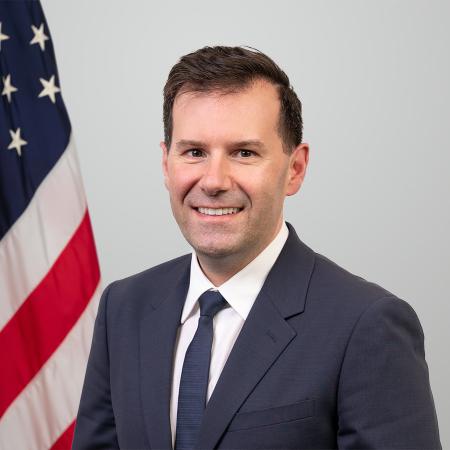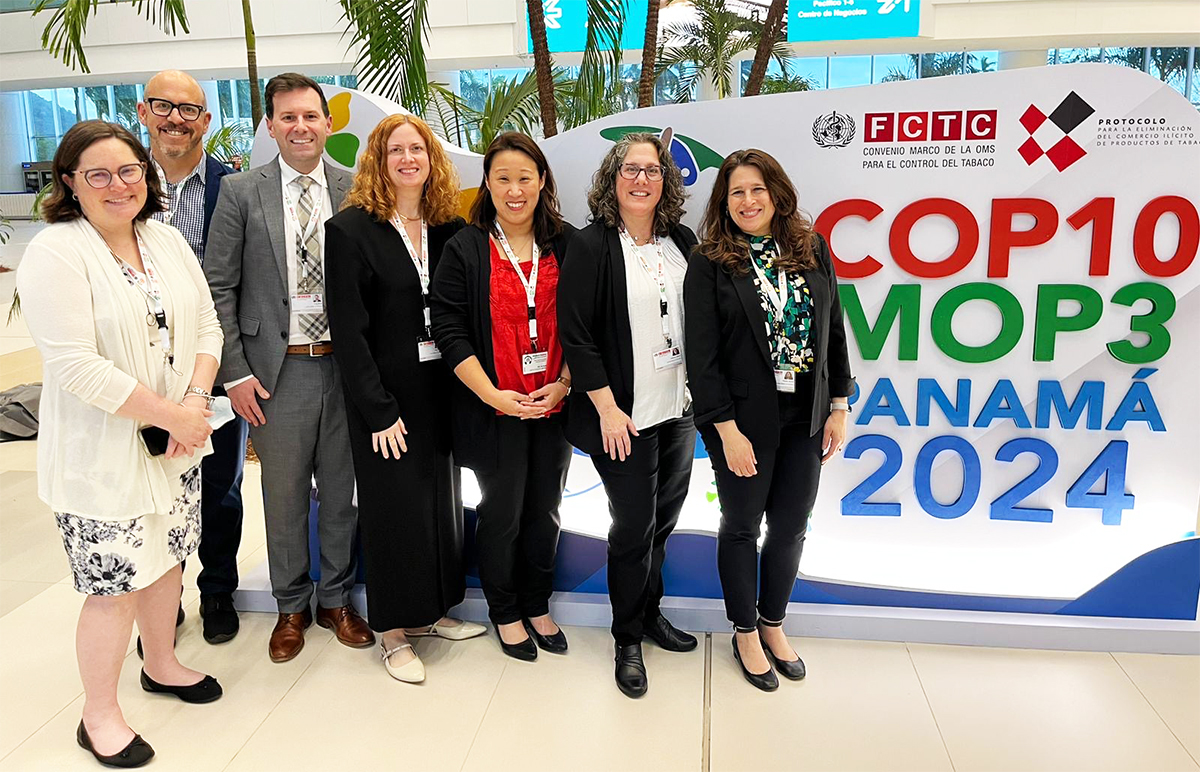FDA’s Engagement in Global Tobacco Control and Prevention Efforts
FROM A GLOBAL PERSPECTIVE
By Brian King, CTP Director
February 28, 2024
The WHO Framework Convention on Tobacco Control (FCTC) is the first treaty negotiated under the auspices of the World Health Organization (WHO). It was developed in response to the globalization of the tobacco epidemic, which has been driven by several factors, including direct foreign investment, global marketing, transnational tobacco advertising, promotion and sponsorship, and the international movement of contraband and counterfeit cigarettes. The WHO FCTC was adopted during the 56th World Health Assembly in May 2003. There are 183 Parties to the WHO FCTC covering more than 90% of the global population. The United States signed the WHO FCTC in 2004 but has not ratified the treaty. The Tenth Conference of the Parties (COP10) took place February 5-10, 2024, in Panama City, Panama, attended by representatives from the Parties, State Non-Parties, and international intergovernmental and nongovernmental organizations.
The Director of the FDA Center for Tobacco Products (CTP), Brian King, MPH, Ph.D., attended the COP10 as a member of the U.S. delegation. Dr. King talked about the conference with OGPS communications staff following his return from Panama.
Why is it important for the United States to attend the COP? And what does the FDA's participation there entail?
With regard to the first question, it's important for us to attend the COP because tobacco use remains the leading cause of preventable disease and death in the United States. Moreover, we still have about half a million Americans that are dying each year from tobacco related disease and death. However, the burden of tobacco use and tobacco-related disease and death is not unique to the United States; there are about 8 million people who continue to die each year from tobacco use globally, including from both active smoking and also secondhand smoke exposure. Therefore, it's critically important that experts from across the world, including regulators, can convene to discuss various regulatory approaches, best practices for tobacco prevention and control, and new research and information.
With regard to the United States’ participation in FCTC, even though we're not a party to the Treaty, we still have signed it. Thus, we are able to attend the COP and engage in dialogue with our global partners. In terms of what exactly that participation entails, it's multifold and occurs before, during, and after the COP. For example, before the COP, we help prepare position papers. The FDA takes the lead on this. During the COP, there's a U.S. delegation, consisting of seven staff from across the Department of Health and Human Services, including from the HHS Office of Global Affairs, FDA, CDC, and NIH. During the COP, the delegation has an opportunity to share its expertise. This includes delivering remarks, formally called an “intervention,” which highlights several regulatory efforts undertaken by the FDA. For the COP10, these efforts included proposed rules to prohibit menthol in cigarettes and all characterizing flavors in cigars, as well as our intent to propose a rule to limit the levels of nicotine in cigarettes. We also discussed the recent expansion of our authority to regulate tobacco products, regardless of the source of nicotine, including synthetic nicotine.
What articles of the FCTC treaty are of most interest to FDA's work?
There are a variety of articles – nearly 20 of them related to specific tobacco control measures – and in a way they're all important to us because they are founded upon evidence-based strategies that are proven effective to help reduce tobacco related disease and death. Articles that are particularly relevant to our regulatory authorities are Articles 9 and 10, which focus on the regulation of the contents and disclosure of tobacco products. Interestingly, these articles are the least implemented by parties to the FCTC, but the U.S. has actually implemented several of these related measures, including those related to ingredient listing submissions and nicotine warning statements. We also have an interest in various other articles, including those around education, communication, and public awareness, as well as those related to illicit trade in tobacco products, packaging and labeling, and underage sales to minors.
How would you characterize our Tobacco Control Act compared to the tobacco authorities of our regulatory counterparts?
Ultimately, there’s no right or wrong way to regulate tobacco products, as it depends on a variety of factors, including the regulatory context in a given country. In the United States, the FDA’s authority to regulate tobacco products includes the manufacturing, distribution, marketing, and sales of these products. This affords us the ability to address a variety of important topics. However, there are some things that we don't have the authority to do that are part of a comprehensive approach, including strategies such as taxation and smoke-free policies. Those strategies are generally adopted at the local and state level.
What key decisions were made at COP 10?
It was a very grueling schedule, including 12-hour days that went late into the evening. But that’s understandable when you have more than 125 countries in a single room, and you want to make sure that everyone has the opportunity to engage in a meaningful way. To help inform dialogue at such a large meeting, there were a combination of broader group sessions and also breakout sessions, including by different WHO regions (the United States is part of the Region of the Americas).
Major decisions at the COP10 included the adoption of a resolution recognizing the environmental impact across the life cycle of tobacco products by implementing or strengthening national policies related to protection of the environment and the health of persons. This decision was in response to growing attention on the environmental impact of tobacco products and the WHO's efforts to develop an international instrument on plastics pollution, which could relate to cigarette filters, disposable e-cigarettes, and other tobacco products.
Additionally, the COP decided to establish an expert group to work on some forward-looking tobacco control measures that go beyond those outlined in FCTC, including those that counter industry tactics to hinder tobacco control. It will help yield some information for consideration by the United States as well as other countries. Further, the COP adopted a decision related to the promotion of human rights through FCTC recognition of the important intersection between human rights and tobacco. Finally, the COP adopted the Panama Declaration, which highlights the conflict between the interests of the tobacco industry and public health interests, and calls for compliance with Article 5.3, which obligates parties to protect public health policies from commercial and other vested interests.
So, the next COP10 is in 2025 – what does CTP hope to accomplish before that next meeting?
We have many things in the queue, and I am really excited and optimistic about the future of CTP. One is to advance a rulemaking to prohibit menthol in cigarettes and all characterizing flavors in cigars. Both of those product standards are in the very final stages of rulemaking and would have a very profound impact on the public health of this country, particularly among the population disproportionately impacted by the use of these products. For example, among U.S. adults, about 8 out of 10 Black smokers use menthol cigarettes compared to about 3 in 10 white smokers.
We're also working to introduce rulemaking to limit the amount of nicotine in cigarettes and certain other combustible tobacco products. If implemented, the rule would have a profound impact on the public health of the country. Nicotine is highly addictive, and so if we were able to set a cap that would make those products either nonaddictive or minimally addictive, it would be an important tool to advance both prevention and cessation.
We're also continuing to conduct premarket review of tobacco product applications, as well as to conduct enforcement against products on the market without FDA authorization. We’ve taken many important actions to enforce the law to date in collaboration with colleagues from across the federal government, including the Department of Justice and Customs and Border Protection, among others. We're also continuing important health communication strategies to educate the public about the risks of tobacco products, such as through youth prevention campaigns. This includes the Center’s long-standing “The Real Cost” public education campaign, which focuses on prevention of tobacco product use, including cigarettes and e-cigarettes, among youth.
Finally, we're also making important strides to achieve health equity. We've made considerable progress in reducing smoking nationally, which has been one of the most remarkable public health achievements of the past century. However, we can't leave people behind and it’s important that we meaningfully address disparities in tobacco product use that persist across population groups, including higher rates of use among persons with lower socioeconomic status, certain race/ethnicities, LGBTQIA+ persons, and others. To meaningfully address disparities, it's important that we intertwine health equity across all of our programmatic work.
What are the other ways that CTP engages on tobacco related issues globally?
In addition to our domestic portfolio, CTP also engages with global partners. One such way is through the Global Tobacco Regulatory Forum (GTRF), which is a key opportunity for us to share information with our regulatory counterparts. This group, which is comprised of regulators from a subset of countries, convenes virtually on a biannual basis and in person once a year, to discuss ongoing global opportunities and challenges to tobacco regulation.
Last year, the annual in-person meeting was held in India and this year it will be held in the Netherlands. These meetings are an important opportunity for the United States, as well as other countries, to engage in meaningful dialogue to help reduce tobacco-related disease and death globally.
Besides the GTRF, we also have confidentiality commitments with other countries, which allow us to conduct information sharing throughout the year. For example, if there's a question from a country that they need help on, we can pull our subject matter experts in and meet with these countries to provide technical support.
And just to clarify, the COP meeting in Panama was open to industry while the global forum is for regulators only?
The GTRF is a smaller forum of a few dozen tobacco regulators who meet on a routine basis. In contrast, the COP is an international treaty that includes a variety of individuals from nearly all countries globally; attendees can include regulators, government officials, and others. Other entities, including nongovernment organizations and the media, can also attend the COP. However, they are only allowed to attend certain “open” sessions.
The tobacco industry is not an active participant in the COP. However, it is possible that they might attend as part of specific country delegation, or be able to attend any of the open sessions that are otherwise available to the general public.
And what does that forum do over time?
The primary purpose of GTRF is for information sharing, including providing expertise to help facilitate more robust and visionary actions on tobacco prevention and control globally. As an example, the United States has shared its experiences pursuing the adoption of product standards, including those to prohibit menthol in cigarettes and all flavors in cigars; this frequently includes discussion of both opportunities and challenges. Ultimately, the discussions at GTRF encompass a variety of topics, ranging from epidemiologic and laboratory expertise to policy and legal discussions.
Brian King, MPH, Ph.D., is the director of the FDA Center for Tobacco Products.



